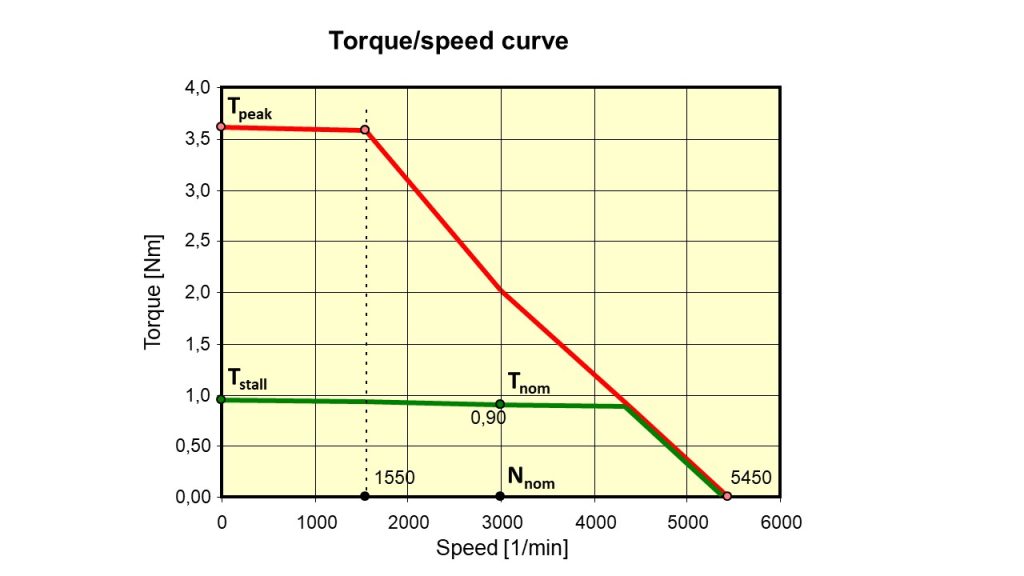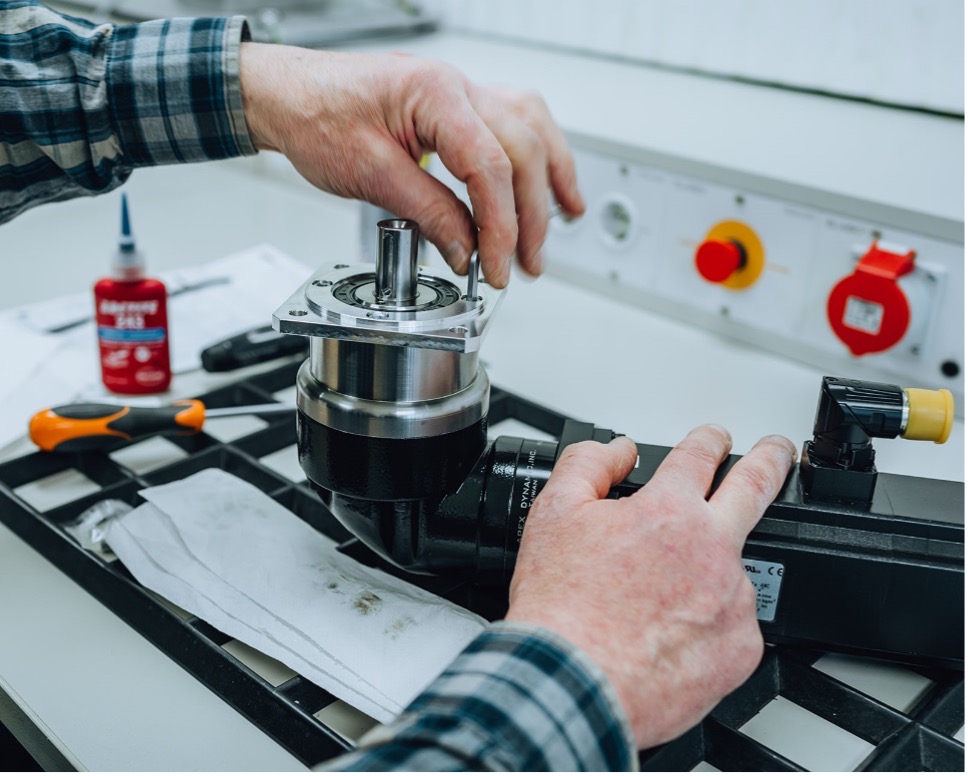Selecting a Servo Motor: The Primary Factors for Sizing
How to Select a Servo Motor? The servo motor is the driving force behind precise mechanical movement and therefore plays a significant role in the functioning and performance of many applications. The selection depends on a multitude of factors, the most important of which we will discuss in this article.
Choosing a Servo Motor: Sizing a Servo Motor
Selecting a servo motor for a motion control application is an iterative process. You must consider not only the motion profile of the application but also the servo motor’s ability to control the application’s speed, position, or torque within the specifications. Additionally, characteristics and environmental conditions must be taken into account to ultimately make an optimal choice. We will go through the following factors:
- Torque-speed curve
- Inertia ratio
- Accuracy
- Efficiency and cooling
- Mechanical motor construction
- Load control for vertical loads
- Environmental conditions
The Torque-Speed Curve of a Servo Motor
To perform a proper selection of a servo motor, the overall system setup of the application must first be known. This includes the mechanical construction with all moving parts. The mass or inertia of the moving parts that need to be driven by the servo motor must be determined. Together with the desired motion profile of the application, the required torques and speeds that the servo motor must deliver can be determined. This should take into account any external disturbance torques.
Several important parameters of a servo motor are depicted in the torque-speed curve.

The green line in the curve represents the nominal torque/speed line. If the servo motor is continuously loaded with torque and speed along this line, the servo motor will not exceed its maximum temperature at a defined ambient temperature. The red line indicates the limits of the servo motor in terms of torque and speed. Under no circumstances should the torque or speed go beyond this curve. This curve is often limited by the voltage and current of the servo controller.
To select the right servo motor, the peak torque and its corresponding speed need to be calculated. As mentioned earlier, this point must fall within the red line. Additionally, the effective torque must be calculated over the entire motion cycle. This effective torque, along with its corresponding speed, should fall within the green line.
Inertia ratio of the servo motor
When sizing a servo motor, the inertia ratio must be considered in most cases. This is the ratio between the inertia of the load (JL) and the inertia of the servo motor (Jm). The inertia ratio is calculated as JL/Jm. A rule of thumb for rotating servo motors is that this ratio is smaller than 10. However, this depends on several factors, such as the desired dynamic behavior, the mechanical stiffness of the drive, and any potential backlash.
In cases where there’s high mechanical stiffness and minimal backlash, a higher inertia ratio can be chosen. For directly coupled servo motors like torque motors, the inertia ratio can be much greater than 100.

Reducing the inertia of the load driven by the servo motor often involves the use of a gear reducer. In servo systems, a planetary reducer is commonly employed for this purpose. Implementing a reducer increases the output torque, lowers the speed, and reduces the inertia.
Support for Servo Motor Selection
VARIODRIVE has extensive experience in selecting servo motors for motion control applications. Our partnership with exclusive brands such as Parker ensures that our knowledge and customization capabilities are unparalleled. Together with our clients, we collaborate on designing and selecting the optimal motion control system for their applications. Interested in discovering how this could work for you? Contact us at sales@variodrive.nl or call us at 0186-636280. We’re here to assist you.
Accuracy of a Servo Motor
A significant property of a servo motor is its ability to position a given load with defined accuracy, maintain that position, and control torque and/or speed. To achieve the desired specifications in terms of absolute, relative, and repeatable accuracy, it’s crucial to select the right type of servo motor equipped with suitable measurement systems. Beyond the servo motor and measurement system, the servo controller and mechanics also influence accuracy. The best results are often achieved through a mechatronic approach, where the entire system is considered, leading to comprehensive selection of all system components.
Servo Motor: Efficiency and Cooling
Servo motors, especially brushless AC servo motors, exhibit very high efficiency (>95%). This is primarily due to the use of powerful rare-earth magnets mounted on the rotor and compact windings on the stator. The power density of a servo motor is consequently very high, which can result in significant heat generation. If the servo motor is continuously loaded along the green line in the torque-speed curve, the temperature increase is usually defined, for example, as +95°C. If the ambient temperature is 21°C, the servo motor would reach 116°C. If the motor needs to be loaded higher than nominal, options such as forced air cooling or even water cooling might be considered. There are cases where servo motors operate fully submerged in oil.
Mechanical Servo Motor Construction
A servo motor comprises a stator housing and a rotor seated within the stator housing. Depending on the application, the rotor and hence the bearings can be subjected to axial and radial loads. These forces, combined with the rotor’s speed, must be factored in to determine the servo motor’s lifespan. The mechanical construction of the servo motor must also account for the thermal expansion of various components, often made from different materials.

Even though a servo motor is already compact, there can be benefits in designing a servo motor that’s fully integrated into the machine design. This can be achieved through frameless or kit motors. These servomotors consist of a stator with windings and a rotor with magnets but without a shaft. Using these components, a flexible solution can be designed for integrating a servo motor. This provides the mechatronics designer with more freedom and flexibility to achieve an optimal solution.
Load Control for Vertical Loads
When a load needs to be moved vertically, the servo motor maintains control of the load as long as the motor delivers torque.

When the servo motor stops delivering torque, for instance due to the servo controller being turned off, the load can fall downward due to gravity. To prevent this, the servo motor can be equipped with a holding brake. Other options include using a gravity compensation system through a pneumatic cylinder, springs, or a counterweight.
Environmental Conditions
Because servo motors can be used in a wide range of processes, the environmental conditions in which they operate must be considered when selecting a servo motor. The requirements for a servo motor used in a cleanroom, for example, are different from those for a servo motor used in the food processing industry. Conditions such as pollution levels, temperature, humidity, and the altitude at which the servo motor is used are all factors to consider when choosing the appropriate servo motor.
Partnering with VARIODRIVE
With an extensive range of servo motors and the ability to provide custom drive systems, VARIODRIVE is the ideal partner for machine builders. Leveraging our years of experience and expertise in drive technology, VARIODRIVE can assist customers in enhancing the efficiency and performance of their machines. Curious about what we can offer you? Get in touch with us at sales@variodrive.nl or call us at 0186-636280. We’re here to assist you.
